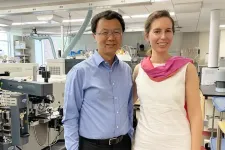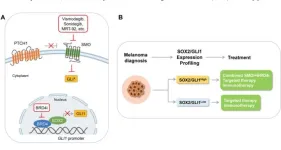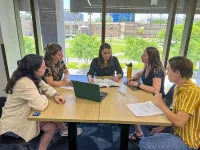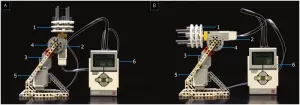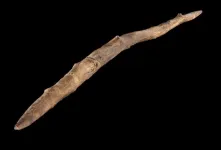(Press-News.org) As molecular biologists at Boston University and as husband and wife, Ruslan Afasizhev and Inna Afasizheva, have worked together for decades. Together, they have published dozens of papers on the mechanics of mitochondrial DNA and RNA in a single-celled, disease-causing parasite called Trypanosoma brucei. Now, years of breakthroughs have led to their latest paper published in Science, which provides a detailed look at a mystifying process called RNA editing and could potentially help treat a deadly disease.
In their newest paper, Afasizhev and Afasizheva—along with collaborators at UCLA, University of California, Irvine (UCI), and ShanghaiTech University—are the first to determine the architecture of the molecular machines that harbor gRNA strands and allow those strands to engage mRNA. Identifying these cellular mechanisms could give scientists essential information for treating African sleeping sickness, the disease caused by Trypanosoma. Spread by tsetse flies that harbor the parasite, African sleeping sickness is usually fatal, and many of the available treatments have safety concerns, making molecular studies particularly important for drug development.
“Now we can start more broader research,” says Afasizheva, a Boston University Henry M. Goldman School of Dental Medicine associate professor of molecular and cell biology. “Since now we know exactly how proteins interact with RNA.”
“If we find a way to inhibit the editing process, we can kill the parasite without harming human cells,” says Afasizhev, who is also a professor of biochemistry at the Boston University Chobanian & Avedisian School of Medicine and corresponding author on the paper.
RNA research has evolved and advanced tremendously—and so has the technology to study the inside of cells. Today, the couple’s team uses cryo-electron microscopy and molecular approaches to provide a detailed understanding of RNA editing. Using this technology, their latest study found that a protein complex called the editosome is responsible for orchestrating changes guided by gRNA, which happen as a cascade of insertions and deletions of uridine, a chemical component of RNA. In Trypanosoma, RNA editing serves an important purpose: fixing a broken gene. Mutations in DNA are very common in the parasite, so even though the genetic code is unreadable, the edited mRNA becomes a functional part of the cell.
RNA editing regulates many cellular processes in nearly all organisms that have cells with a nucleus and mitochondria. But, Afasizhev says, the RNA editing mechanisms in different organisms have nothing in common, meaning those mechanisms evolved for different purposes specific to different species. This is what makes the RNA editing mechanisms of Trypanosomes an attractive therapeutic target for stopping the parasite from causing disease, since it won’t interfere with human cells. Now that they know the protein structures unique to RNA editing in Trypanosomes, the next phase of their research is identifying the enzymes that ignite the reactions in the cell.
“The next question is how these reactions happen, how these enzymes come to the substrate, and how they create the magnificent work to change the RNA sequence,” Afasizheva says.
She and Afasizhev hope to bring in more students to their lab who can embrace the technological advances in their field, and continue to solve this complicated puzzle, just as they have.
This study was funded by the National Institutes of Health.
END
Molecular biologists identify framework for understanding RNA editing in a disease-causing parasite
From Moscow to Boston, these two molecular biologists built their lives and careers together studying RNA in a disease-causing parasite
2023-07-19
ELSE PRESS RELEASES FROM THIS DATE:
Picturing where wildlands and people meet at a global scale
2023-07-19
Researchers led by a team at the University of Wisconsin–Madison have created the first tool to map and visualize the areas where human settlements and nature meet on a global scale. The tool, which was part of a study recently published in Nature, could improve responses to environmental conflicts like wildfires, the spread of zoonotic diseases and loss of ecosystem biodiversity.
These areas where people and wildlands meet are called the wildland-urban interface, or WUI for short. More technically, a WUI (pronounced “woo-ee”) describes anywhere that has at least one house per 40 acres and is also 50% covered by wildland ...
Using new method, study highlights physician turnover trend
2023-07-19
Using an innovative method for measuring doctor turnover, Weill Cornell Medicine researchers determined that between 2010 and 2018, the annual rate at which physicians left their practices increased by 43 percent, from 5.3 percent to 7.6 percent a year. The causes of this trend are not known, but warrant further investigation, according to the researchers.
The study, published July 11 in the Annals of Internal Medicine, also found that the first three quarters of 2020 (the start of the COVID-19 pandemic in the United States) were not associated with higher turnover. However, more data are needed to fully understand turnover trends related to COVID-19.
Whether doctors ...
Winery experiences affected by more than what is in your glass
2023-07-19
New research from the University of British Columbia's Okanagan campus has determined that enjoying a tasting at a winery goes well beyond the sip.
Professor Annamma Joy, with UBCO’s Faculty of Management, conducts research in the area of consumer behaviour and branding with a special focus on luxury brands, fashion brand experiences, wineries and wine tourism.
Dr. Joy, along with her collaborators and students, studied several Okanagan wineries over a three-year period to comprehensively document the experiences ...
Researchers use mass spectrometry to explore antimicrobial resistance
2023-07-19
Laura-Isobel McCall, Ph.D., and Zhibo Yang, Ph.D., co-principal investigators and associate professors of chemistry and biochemistry in the Dodge Family College of Arts and Sciences at the University of Oklahoma, have been awarded a prestigious R01 grant from the National Institutes of Health for their project, “Novel single-cell mass spectrometry to assess the role of intracellular drug concentration and metabolism in antimicrobial treatment failure.”
“Our project builds upon Dr. ...
Novel therapeutic strategy against melanoma: combined targeting of hedgehog signaling and BRD4
2023-07-19
“This evidence strengthens the relevance of the findings by Pietrobono et al., shedding light on the potential application of SMO inhibitors in concert with BRD4 inhibitors.”
BUFFALO, NY- July 19, 2023 – A new editorial paper was published in Oncotarget's Volume 14 on May 26, 2023, entitled, “Combined targeting of HEDGEHOG signaling and BRD4 as a novel therapeutic option against melanoma.”
The Hedgehog-GLI (HH/GLI) pathway is aberrantly activated in several types of cancer. Canonical HH/ GLI pathway is triggered by binding of HH ligands to the twelve-pass transmembrane receptor Patched 1 (PTCH1), which retrieves its inhibition ...
Large study finds small associations between systemic inflammation and later dementia
2023-07-19
A study of data from about 500,000 people in the UK Biobank has uncovered small but statistically significant associations between signs of systemic inflammation and later risk of dementia. Dr. Krisztina Mekli of The University of Manchester, UK, and colleagues present these findings in the open-access journal PLOS ONE on July 19, 2023.
Millions of people around the world have Alzheimer’s disease or other types of dementia, and researchers are working to tease out the complex mechanisms behind these conditions. Prior research has suggested that inflammation—activation of the body’s innate immune system—may ...
STEM instructors who are women drive disclosure of concealable stigmatized identities to undergraduates
2023-07-19
Women working as STEM instructors are more likely than men in the same profession to disclose to their undergraduate students identities which could carry stigma, such as depression or growing up in a low-income household. In the new study, published July 19, 2023 in the open-access journal PLOS ONE, Carly Busch of Arizona State University, USA, and colleagues suggest that these decisions to disclose may be in order to act as role models for students.
Concealable stigmatized identities (CSIs) are identities that ...
Researchers used a LEGO robotics kit as a cheap, effective way to purify self-assembling DNA origami
2023-07-19
Article URL: https://journals.plos.org/plosone/article?id=10.1371/journal.pone.0283134
Article Title: Gradient-mixing LEGO robots for purifying DNA origami nanostructures of multiple components by rate-zonal centrifugation
Author Countries: USA
Funding: The research in Hariadi lab was supported by the National Institutes of Health Director’s New Innovator Award (1DP2AI144247), National Science Foundation SemiSynBio II (2027215), and Arizona Biomedical Research Consortium (ADHS17-00007401). The funders had no role in study design, data collection and analysis, decision to publish, or preparation of the manuscript. END ...
A 300,000 year-old double-pointed wooden stick was produced by Middle Pleistocene humans using sophisticated woodworking techniques and was likely used for throwing during hunts
2023-07-19
Article URL: https://journals.plos.org/plosone/article?id=10.1371/journal.pone.0287719
Article Title: A double-pointed wooden throwing stick from Schöningen, Germany: Results and new insights from a multianalytical study
Author Countries: UK, Germany
Funding: T.T. and this project are funded by the Deutsche Forschungsgemeinschaft (DFG, German Research Foundation) – project number 447423357. https://www.dfg.de/. The project is further funded by the Lower Saxony Ministry for Science and Culture, with funds from the Future Lower Saxony Programme of the Volkswagen Foundation – project ...
1 in 5 rabbit owners in the UK report painful or debilitating ear disease in their pet, though it may be under-diagnosed and under-treated, with lop-eared and older rabbits being most at risk
2023-07-19
Article URL: https://journals.plos.org/plosone/article?id=10.1371/journal.pone.0285372
Article Title: Ear health and quality of life in pet rabbits of differing ear conformations: A UK survey of owner-reported signalment risk factors and effects on rabbit welfare and behaviour
Author Countries: UK
Funding: The authors received no specific funding for this work. M.R.D.K included some of this questionnaire in part-fulfilment of her Bachelor of Veterinary Medicine at Royal Veterinary College. ...
LAST 30 PRESS RELEASES:
Heart disease, stroke deaths down, yet still kill more in US than any other cause
Light switches made of ultra-thin semiconductor layers
Creative talent: has AI knocked humans out?
Sculpting complex, 3D nanostructures with a focused ion beam
A year after undermining Bredt’s rule, UCLA scientists have made cage-shaped, double-bonded molecules that defy expectations
Human activities drive global dryland greening
PeroCycle announces new appointments as it builds a world-class board for meaningful climate impact
Magnetic avalanches power solar flares
LeapSpace goes live: the Research-Grade AI-Assisted Workspace built on trusted science
DNA tests reveal mysterious beluga family trees
Strategic sex: Alaska’s beluga whales swap mates for long-term survival
How early cell membranes may have shaped the origins of life
Cannabis legalization is driving increases in marijuana use among U.S. adults with historically lower consumption rates
Multifunctional dipoles enabling enhanced ionic and electronic transport for high‑energy batteries
Triboelectric nanogenerators for future space missions
Advancing energy development with MBene: Chemical mechanism, AI, and applications in energy storage and harvesting
Heteroatom‑coordinated Fe–N4 catalysts for enhanced oxygen reduction in alkaline seawater zinc‑air batteries
Meta-device for precision lateral displacement sensing
Plasma-guided mitotane for the treatment of adrenocortical carcinoma: adjuvant care to advanced disease
Theoretical study of laser-enhanced nuclear fusion reactions
Social environment impacts sleep quality
Optimized kinetic pathways of active hydrogen generation at Cu2O/Cu heterojunction interfaces to enhance nitrate electroreduction to ammonia
New design playbook could unlock next generation high energy lithium ion batteries
Drones reveal how feral horse units keep boundaries
New AI tool removes bottleneck in animal movement analysis
Bubble netting knowledge spread by immigrant humpback whales
Discovery of bats remarkable navigation strategy revealed in new study
Urban tributaries identified as major sources of plastic chemical pollution in the Yangtze River
UK glaucoma cases higher than expected and projected to reach 1.6 million+ by 2060
Type 2 diabetes prevention could more than halve carbon footprint linked to disease complications
[Press-News.org] Molecular biologists identify framework for understanding RNA editing in a disease-causing parasiteFrom Moscow to Boston, these two molecular biologists built their lives and careers together studying RNA in a disease-causing parasite




